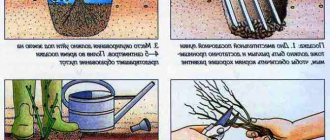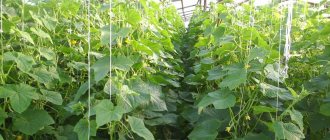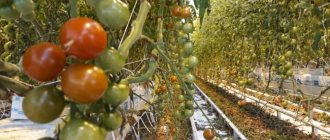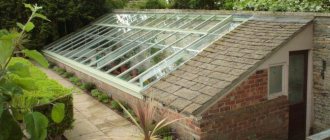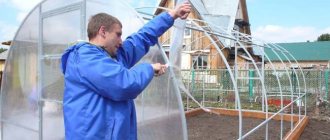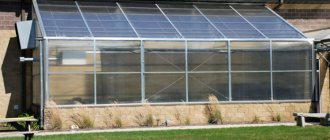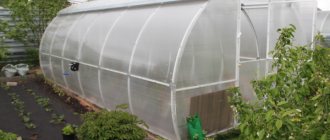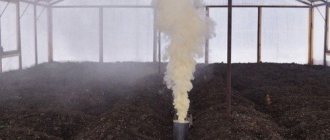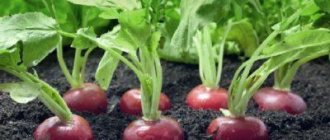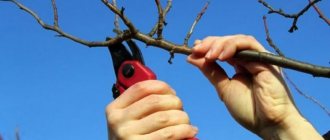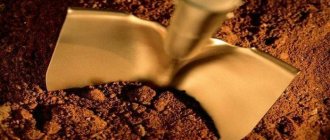The columnar apple tree is an ideal option for those gardeners who do not have a lot of time to garden. They will fit well into the garden of those who do not have as much free space as they would like for planting ordinary plants. In Russia and its environs, weeds have been grown for about half a century. However, the columnar apple tree, planting and caring for which is quite simple, still causes some gardeners to be slightly wary.
Garden of columnar apple trees.
General landing rules
For the normal development of a columnar apple tree, several conditions must be taken into account:
- Fertile light and sandy or loamy soil. If it is not, then the structure will need to be improved as much as possible.
- Place in the sun and protected from strong gusts of wind.
- Columns love a sufficient amount of moisture, so you will need to take care of proper watering.
- Plants do not like groundwater to be close to the roots, even though the root system is completely superficial.
- Many columnar varieties of apple trees have excellent immunity to various diseases. They can adapt to weather changes. But it is necessary to choose a variety that is suitable for the climatic conditions of the region.
The seedling must be young, preferably one year old, healthy, without damage or visual signs of pest exposure. Then planting will take place without problems, and the plant will quickly grow.
Application in the garden
With the help of columnar apple trees you can achieve many goals on your site at once:
- create a unique landscape element using these plants as a design move (solitary planting),
- effective division of the site into zones (fruit wall or trellis),
- practical increase in the productivity of your orchard on several acres,
- or you will simply surprise others with the spectacular appearance of these trees.
Gail Langellotto / Flickr.com
Preparing for landing
The landing procedure is quite simple. It is practically no different from moving seedlings of normal size into the ground. But before moving on to it, you need to properly prepare. There are several important features that will need to be taken into account.
Selecting a location
The place for planting a columnar apple tree should first of all be sunny. The small apple tree is very heat-loving; the fruits will appear and ripen only if they receive as much sun as possible.
Columnar plants, and especially young crops, are very susceptible to the influence of wind. Therefore, it is necessary to place them in a place where they will not be greatly affected by gusts of cold wind.
There is no exact mandatory figure for how much space to leave for the speakers. They can grow even a meter apart from each other, outbuildings, fences or other crops. It is only necessary to take into account the above basic requirements. The standard or generally accepted scheme is meter by meter.
Diagram of distances between apple trees.
Seedling storage
Seedlings of columnar apple trees are quite expensive, which often confuses gardeners. That is why you cannot resort to various experiments, and buy them only in special nurseries. Dishonest sellers may try to pass off an underdeveloped seedling of a regular variety as a column. It is necessary to inspect the plant before purchasing. It must be healthy, annual, without damage or signs of dryness, have one shoot completely without shoots.
There is one important feature that needs to be taken into account. Columnar seedlings do not like to be exposed to air for a long time, much less in the sun. Therefore, they need to be moved into the ground as quickly as possible after purchase. If you plan to transport over a long distance for a long time, then it is better to choose seedlings with a closed root system. If this is not possible, then you can wrap the roots with a damp cloth.
Pit preparation
The planting pit for columnar apple trees is the same as for ordinary ones, only smaller in size. Proportions of 40*50 cm in width and height are sufficient to provide enough space for the roots.
Well prepared hole for planting.
Nutrients are also added to it. These are ash, superphosphate, humus, peat and potassium mixed with fertile soil. In the spring, it is recommended to add a little nitrogen, which will stimulate the apple tree to grow vegetative shoots. The planting pit is prepared at least 3 weeks in advance, and even better from last season.
Root treatment
Before planting plants, you need to place the roots in a bucket of warm water for a short time, about 12 hours. Some gardeners even advise adding a little growth stimulants to this water. Immediately before placing the roots of the seedling in the hole, they need to be dipped in a clay mash.
The main advantages of columnar fruit trees
A new variety of miniature fruit “dwarfs” has gained enormous popularity due to the fact that when comparing the yield of gardens of the same occupied area (traditional and columnar), columnar gardens take the lead in profitability and convenience.
Since the plants are not tall, it is easier to treat them against pests, it is easier to carry out annual pruning of branches, and it is convenient to collect ripe fruits. And the most important argument in favor of trees with a narrow and elongated crown is that their fruiting begins in the second or third year after planting, and ordinary fruit trees begin bearing fruit in 4-5 years.
On an area of one hectare you can place a garden of two thousand columnar plants, while for ordinary fruit trees with a wide crown, no more than 400 trunks can fit there.
Consequently, more fruit-bearing plants fit into the same area, and the costs of maintaining and caring for them are much lower.
Planting scheme
Columnar apple trees are very compact crops. Thanks to these properties, they can be planted even at a distance of 30-40 cm from each other. However, the best option is considered to be planting according to the meter by meter scheme.
Technology
Planting is carried out according to the usual, fairly simple scheme. Here are simple step-by-step instructions:
- Make a small hill in the prepared hole from fertile soil and fertilizers.
- It is necessary to install a seedling on this hill and carefully straighten the roots.
- You need to make sure that they don’t bend anywhere.
- It should be filled with soil without lumps and watered well so that there are no voids.
Scheme of proper planting of an apple tree.
After planting, it is necessary to install a support next to the seedling so that it is not damaged by strong winds.
In sandy soil
Depending on the composition of the soil, there are several differences in the planting procedure. If the soil is sandy, you need to add a little clay to it to create a waterproofing effect.
In clay soil
It is very important to ensure that moisture does not accumulate in clay soil, which negatively affects the roots of the plant. That is why the hole must be quite large so that it can accommodate a drainage cushion made of crushed stone, sand and pieces of brick.
At high groundwater levels
If the groundwater level in the area is high and it is not possible to choose a more or less level place, you will need to plant columnar varieties of apple trees on special fences or hills. If possible, gardeners advise installing a drainage system on the site.
Vaccinated to the south
It is believed that it is with this planting that plants grow best. Experienced gardeners say that this is due to the activity of the sun. But it is important to consider that the grafting site should always be about 4-5 cm above the ground level, even after the soil settles.
Determination of the vaccination site.
Content
- Application in the garden
- Purchasing a seedling Beware of fakes
- Trust trusted sellers
- Attention to the rootstock
- Age and number of seedlings
- Not necessary
Mareefe / Personal archive
There is probably not a single gardener who would not like this amazing fruit plant , accidentally given to us by nature. A careful look from a gardener, an experiment in grafting unusual cuttings - and now everyone can afford to have a beautiful columnar apple tree .
Aesthetically beautiful, miniature and compact, richly strewn with bright fruits - it immediately attracts the eye.
Prosperity / Personal archive
Peculiarities
Usually there are no special features for planting columnar varieties of apple trees. They are planted just like any other. Only when preparing the planting hole should you take into account that the nutritional needs of the apple tree are two times less, and therefore regulate the amount of fertilizer applied to the planting hole. But the size of the crop may be a concern for some.
Single landing
When planting alone, it must be taken into account that for normal development it only needs the sun. Therefore, it will be enough to ensure that the sun does not cover any buildings or gatherings.
But many gardeners do not plant columns individually solely for ethical reasons. When planted alone they look a little strange.
Planting several different varieties side by side
Many gardeners wonder whether it is possible to plant several columnar apple trees, which belong to different varieties, side by side. Experience shows that it is possible. But it is necessary to take into account their ripening time. Thus, summer varieties are planted next to summer varieties, and autumn varieties - with the same neighbors. Accordingly, winter-ripening varieties should be located side by side.
Group plantings
Due to their small size, columnar varieties of apple trees are very popular with those who plant them in group plantings. It is best to determine the location at a distance of 50-60 cm between crops and 100 cm between rows.
Columnar apple trees planted in groups.
The principle of organic farming
Some adherents of the principles of organic farming consider the columnar apple tree to be an ideal neighbor when placing such a planting.
It does not take up much space and is not an aggressive neighbor, thanks to which other garden crops, vegetable plantings and fruit bushes will feel quite comfortable around.
Story
In 1964, in Canada, breeders accidentally discovered an unusual branch on an old McIntosh apple tree. There were absolutely no lateral processes on it. Gardeners were interested in this fact, and the natural mutation was taken as the basis for creating a new type of apple tree. In 1976, English breeders from the county of Kent managed to develop the first examples of such trees.
Differences by season
Columnar apple trees adapt equally well to planting in spring and autumn. But there are some rules that will distinguish these procedures from one another.
Spring
Planting in spring is preferable for speakers in the middle zone. This is primarily due to the fact that the apple tree’s resistance to low temperatures is rather weak.
Fertilizer application
The planting hole for a columnar apple tree, which will be placed in the ground in the spring, must be prepared in the fall. It is prepared in a standard size of 45*50 cm, but if drainage is needed, it is dug 2-3 times deeper. Organic fertilizers, superphosphate, wood ash and potassium are mixed into the top layer of nutrient soil. Mix everything and leave until spring.
Applying fertilizer to the apple tree in the spring.
Autumn
Small trees can also be planted in the fall. This is done more in those regions where the winter is quite warm. Planting will be carried out when the leaves have already fallen, and there are about 3 weeks left before the cold weather.
Scheme
The planting pattern for autumn is the same as for planting in spring. In group plantings, you need to leave up to a meter between rows.
Fertilizer application
When planting in autumn, fertilizers are not recommended to be applied to open ground. This is due to the fact that the plants will be stimulated to grow, but in cold climates, in winter, they may die. It’s better to water it a little and postpone the rest of the care procedures until spring.
Trimming
When planting, one-year-old seedlings are not pruned. This is a very important procedure that is maintained both in spring and autumn. Some gardeners make this mistake. This is a column, which means that it has one central shoot, which under no circumstances should be cut off. Already in the second year, small branches will appear; they will need to be cut into two buds.
Scheme for pruning a columnar apple tree in the fall.
Pruning columnar apple trees
For some varieties of columnar apple trees, pruning is not a mandatory procedure. As a rule, only the main shoot develops in such trees. Long side shoots are formed only when the apical bud is damaged. In this case, the strongest of them is left (it should not be shorter than 20 cm), the rest are cut off, and the removal areas are greased with garden varnish or oil paint.
At the same time, a number of varieties of columnar apple trees require formative pruning. In the first year, in early spring, almost all the side branches are cut off, leaving only two buds on each, from which strong annual shoots grow. Next year, the horizontal branch is left for fruit formation, and the vertical branch is cut again at the level of two buds, which will produce new shoots. After a year, the fruiting branch is cut into a ring. When forming fruit links, it is advisable to remove excess side shoots while they are still green; in this case, the pruning areas will heal faster. Formative pruning cannot be carried out after the start of sap flow.
Formative pruning of columnar apple trees is usually carried out in early spring before sap flow begins.
Main varieties
Thanks to the constant work of breeders, quite a few varieties of columnar apple trees appear, which differ in ripening time and regionalization. This is a list of only those that you should pay attention to.
Summer
These varieties are distinguished by the rapid appearance of fruit. They are eaten fresh and used to prepare various sweets and desserts. However, the fruits are practically not stored. Among them are:
- Nectar. Sweet semi-dwarf with good immunity and large fruits.
- The president. Ruddy juicy apples with a fragrant aroma. The apple tree is small, up to 2 meters tall, and needs support.
- Ostankino. A fairly tall tree by column standards, about 2.5 meters, by the end of summer it is completely covered with juicy apples of an unusual, slightly vague shape.
This is a subjective list that was compiled in no particular order. There are also a large number of varieties with good characteristics.
Autumn
Representatives of autumn varieties are ready for fresh consumption immediately after harvest, but retain their qualities for some time:
- Malyukha. Low-growing, high-yielding variety with lots of juicy fruit.
- Gin. One of the few varieties with good resistance to low temperatures.
- Triumph. A variety with small fruits that have crisp, sweet flesh.
There are other representatives of autumn varieties, among which you can choose those suitable for almost any type of climate.
Winter
Winter apples received popular love for their ability to be stored until spring:
- Amber necklace. A cold-resistant variety with ruddy fruits, the advantages of which are juicy pulp.
- Currency. Early-growing variety with large fruits.
- Yesenia. An apple tree with good immunity and resistance to cold.
These apple trees and other winter weeds have a long shelf life.
For the Moscow region
The climate of the Moscow region is not hospitable, so it is necessary to plant apple trees here that have good immunity to scab and are able to withstand changes in ambient temperature. For this purpose, the Moscow Necklace, Currency, Vasyugan or Malyukha are best suited.
For Siberia
In this region, you need to choose only those columnar fruit crops that can withstand severe frosts, and there are not very many of them. The President, Vasyugan, Iksha and Barguzin will be suitable.
How to deal with pests and diseases of a columnar apple tree
To destroy pests when growing columnar apple trees, insecticides are used that destroy not only the harmful insects themselves, but also their eggs and larvae. Fungicides are used to prevent fungal diseases. Spraying is carried out in the spring before flowering. In this case, the composition must be shaken periodically, otherwise, as a result of separation, its effectiveness may decrease. First, it is worth carrying out a test spraying of one tree. If burns appear on young leaves, it is necessary to reduce the concentration or replace the drug.
For spraying, you can use both complex and single preparations, for example:
- copper sulfate - prevents rotting and the development of fungal diseases, also promotes wound healing, destroys some insects (100 g of 1% copper sulfate per 10 liters of water);
- colloidal sulfur is an effective remedy against powdery mildew, scab, anthracnose, ascochyta blight and plant mites, effective for 12 days after spraying (80 g of the drug per 10 liters of water).
In May, after flowering has ended, repeat spraying is carried out to destroy caterpillars, moths, aphids, mites, etc. For this purpose, you can use a solution of chlorophos (70 g per 10 liters of water), Lepidocide (70 ml per 6 liters of water) or any drug with a similar effect.
In addition, trapping belts made of corrugated paper, which prevent insects from moving up the trunk, can help in pest control.
- How to protect apple and pear trees from diseases and pests
The most effective ways to combat common diseases and pests of apple and pear trees.
Caring for Columnar Trees
In order for columnar fruit trees in the garden to delight with beautiful flowering and rich harvests, they need to be given attention at least once a season. Compared to tall ones, they are more capricious, but caring for such plants is greatly simplified due to their compactness.
Top dressing
During fruit ripening, trees absorb maximum nutrients from the soil, so their supply should be replenished annually. In the spring, humus, nitrogen and nitroammophoska are added under the roots, which promote active growth. In autumn, substances are used to increase winter resistance - phosphorus and potassium. The fertilizer rate is calculated based on the type and age of the tree, taking into account the instructions for each selected preparation.
Trimming
Fruit trees with a columnar crown are pruned as strong side branches appear on them - they are removed completely, covering the cuts with garden pitch. Too long shoots are shortened in the summer so that nutrients are directed to the fruits and not to the growth of the wood. In the fall, if necessary, the main trunk is shortened and branches that are too thick are cleared.
Preparing for winter
Since the roots of columnar trees are shallow, they must be protected from frost first. This is especially true for young seedlings and heat-loving stone fruit crops. To insulate the root zone, you can use fallen leaves, straw, and pine litter - air will penetrate through them, and during thaws the trunk will not rot. It is useful to put burlap or spruce branches on top. To prevent rodents from damaging the delicate bark, it makes sense to use a fine-mesh mesh. If severe frosts are coming, it would not hurt to protect the trees entirely by wrapping their trunks with padding polyester, paper, old clothes, or covering them with a special “tent”. If the upper bud of the trunk dies due to frost, the plant may lose its columnar shape and begin to grow side branches.
Advantages and disadvantages
In addition to their interesting appearance, columnar fruit trees have some advantages over ordinary ones. Their advantages include:
- compactness, allowing you to save space in the garden;
- low growth, which greatly facilitates processing and simplifies the collection of fruits or berries;
- good yield;
- the ability to plant trees near buildings and where shadow from a wide crown is undesirable;
- aesthetics, high decorative qualities.
Among the disadvantages of columnar trees, gardeners note:
- reduced resistance to frost;
- short fruiting period (this means that after 10-15 years the plants will have to be uprooted);
- greater need for care, since surface roots cannot obtain enough moisture and minerals from the depths;
- high cost of seedlings.
